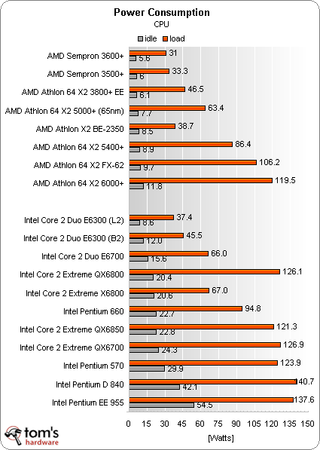Energy-Efficient Computing Options
Processors

Which is the best processor for a power-efficient computer? The answer isn't that easy, as it depends on your workloads. Obviously, a minimum-power requirement isn't all you want, and you should have at least a certain level of performance as well, hence it has to be a dual-core processor today. As you can see in the chart above, almost all AMD processors for socket AM2 have an idle power requirement of less than 10 W, which is an excellent result. Intel was but only recently able to match this low idle power requirement with the L2 and G steppings, moving the Core 2 Duo E6000 family below the 10-W idle power requirement as well. However, AMD's energy-efficient Athlon 64 X2 3800+ EE still is the dual-core processor that requires the least idle power at only 6.1 W.
Yet you shouldn't forget the power requirement at load, which is considerably higher with Athlon 64 X2 processors than with the Core 2 Duo family. All high-end Athlon 64 X2 processors are still based on AMD's 90-nm process, while several mainstream processors are based on the 65-nm manufacturing. The latter are capable of competing with the Core 2 Duo in terms of maximum power requirements, and they underbid them in idle power. However, if you purchase and AMD Athlon 64 X2 and a Core 2 Duo at roughly the same price point, the Core 2 will usually outperform the AMD processor. Have a look at our CPU Charts for detailed comparisons of most AMD and Intel processors available today. The power requirement considerations combined with Intel's performance advantage makes the Core 2 Duo the better choice for energy-efficient computers - but only if you stay away from high-end motherboards with energy-hungry chipsets. Here, AMD has had a small advantage in energy efficiency. Our recommendation is to go with AMD if you care more for low-energy requirements and if your system will be in idle most of the time. If you intend to have the system work on computing-intensive tasks such as video transcoding, encoding, rendering, etc. once in a while, then the Core 2 with a decent motherboard likely is the better choice.
Finally, I would like to mention low-power and mobile processors, which of course are another option you can go for. These consume even less energy, but they'll also require a motherboard with the suitable processor socket: socket S1 for Turion 64 X2 processors and socket 479M for Intel's mobile Core 2 Duo family. However, the mobile components have one major disadvantage: they're unreasonably expensive, as the quantities are small. And the most attractive ultra-low voltage processors are not even available for ZIF sockets.
Expect to fork out at least $200 for a MoDT (Mobile on Desktop) motherboard that utilizes a 965GM chipset as opposed to $60 to $100 for a conventional G965 or G33 solution. This is even more difficult for AMD platforms, as there is hardly any ATX or MicroATX motherboard with socket S1. Sophisticated low-power solutions make sense in very specialized environments; but for an average user looking for a good bang for the buck and reasonable power requirements, they are not the best choice. You end up spending more money on low-power components than you can ever save by the reduced power requirements.
Related Articles:
- Energy Efficiency: AMD vs. Intel
- AMD's Smart Strike: Athlon X2 BE-2350
- Which Is the Best Mainstream CPU?
- Can AMD's 65-nm Core Fight Back?
- Green Machine: AMD Dual Core Platform at 54 W
- The AMD and Intel Energy Crisis
- The P4 560's Heat Can Crash and Kill
- 2007 CPU Charts
Stay on the Cutting Edge
Join the experts who read Tom's Hardware for the inside track on enthusiast PC tech news — and have for over 25 years. We'll send breaking news and in-depth reviews of CPUs, GPUs, AI, maker hardware and more straight to your inbox.
Most Popular

